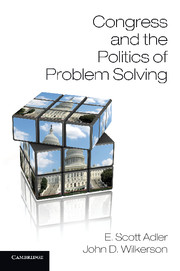6 - Rethinking Committee Reform
Published online by Cambridge University Press: 05 January 2013
Summary
It would be terribly unfortunate if the House had to continue working under its outmoded and obsolete system of jurisdictions.… Congress must organize itself so that it can unify its programs and policies in these important areas rather than continue to work on these problems in an uncoordinated and often counterproductive way.
Rep. Bill Frenzel (R-MN) speaking in favor of the Bolling Committee reform recommendations in 1974.Committee structures enhance legislative capacity and lower information costs through a division of labor and clearly defined issue responsibilities. A problem-solving account of committee organization implies that committee jurisdictional reforms are a response to Congress’s diminished problem-solving capacity. As new issues arise and old ones get redefined, existing jurisdictional arrangements no longer align with contemporary policy challenges – as Frenzel argues in the preceding text. We anticipate that reforms unify programs and policies in important areas with the goals of promoting improved policy coordination and information sharing.
In this chapter, we examine the Bolling-Hansen reforms of 1975, which included the largest set of jurisdictional changes (58 in total) since the Legislative Reorganization Act of 1946 (P.L. 79-601). Previous studies have concluded that the Bolling-Hansen reforms had little impact on the overall organization of the committee system (King 1997, 58; Wolfensberger 2004, 2). However, no previous study has investigated their effects on where bills are being referred – the “best” indicator of a committee’s jurisdiction (Evans 1999). We ask three related questions: Did the reforms substantially alter existing bill-referral practices? If so, what objectives best explain the changes adopted? Finally, did the reforms produce a measurably improved committee system for problem solving?
- Type
- Chapter
- Information
- Congress and the Politics of Problem Solving , pp. 91 - 115Publisher: Cambridge University PressPrint publication year: 2013

